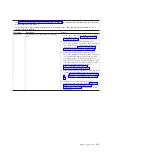
If the diagnostic programs do not detect any hardware errors but the problem
remains during normal server operations, a software error might be the cause. If
you suspect a software problem, see the information that comes with your
software.
A single problem might cause more than one error message. When this happens,
correct the cause of the first error message. The other error messages usually will
not occur the next time you run the diagnostic programs.
Exception:
If there are multiple error codes or light path diagnostics LEDs that
indicate a microprocessor error, the error might be in a microprocessor or in a
microprocessor socket.
If the blade server stops responding during testing and you cannot continue,
restart the blade server and try running the diagnostic programs again. If the
problem remains, replace the component that was being tested when the blade
server stopped.
The diagnostic programs assume that a keyboard and mouse are attached to the
BladeCenter unit and that the blade server controls them. If you run the diagnostic
programs with either no mouse or a mouse attached to the BladeCenter unit that is
not controlled by the blade server, you cannot use the
Next Cat
and
Prev Cat
buttons to select categories. All other mouse-selectable functions are available
through function keys.
To view server configuration information such as system configuration, memory
contents, interrupt request (IRQ) use, direct memory access (DMA) use, or device
drivers, select
Hardware Info
from the top of the screen.
Diagnostic text messages
Use this information to understand the diagnostic text messages that display while
the tests are running.
A diagnostic text message contains one of the following results:
Passed:
The test was completed without any errors.
Failed:
The test detected an error.
User Aborted:
You stopped the test before it was completed.
Not Applicable:
You attempted to test a device that is not present in the blade
server.
Aborted:
The test could not proceed because of the blade server configuration.
Warning:
The test could not be run. There was no failure of the hardware that was
being tested, but there might be a hardware failure elsewhere, or another problem
prevented the test from running; for example, there might be a configuration
problem, or the hardware might be missing or is not being recognized.
The result is followed by an error code or other additional information about the
error.
Chapter 6. Diagnostics
187
Summary of Contents for BladeCenter HS22V 7871
Page 1: ...BladeCenter HS22V Type 7871 and 1949 Problem Determination and Service Guide...
Page 2: ......
Page 3: ...BladeCenter HS22V Type 7871 and 1949 Problem Determination and Service Guide...
Page 16: ...xiv BladeCenter HS22V Type 7871 and 1949 Problem Determination and Service Guide...
Page 20: ...4 BladeCenter HS22V Type 7871 and 1949 Problem Determination and Service Guide...
Page 34: ...18 BladeCenter HS22V Type 7871 and 1949 Problem Determination and Service Guide...
Page 64: ...48 BladeCenter HS22V Type 7871 and 1949 Problem Determination and Service Guide...
Page 112: ...96 BladeCenter HS22V Type 7871 and 1949 Problem Determination and Service Guide...
Page 240: ...224 BladeCenter HS22V Type 7871 and 1949 Problem Determination and Service Guide...
Page 244: ...228 BladeCenter HS22V Type 7871 and 1949 Problem Determination and Service Guide...
Page 252: ...236 BladeCenter HS22V Type 7871 and 1949 Problem Determination and Service Guide...
Page 257: ......
Page 258: ...Part Number 00Y8038 Printed in USA 1P P N 00Y8038...
















































